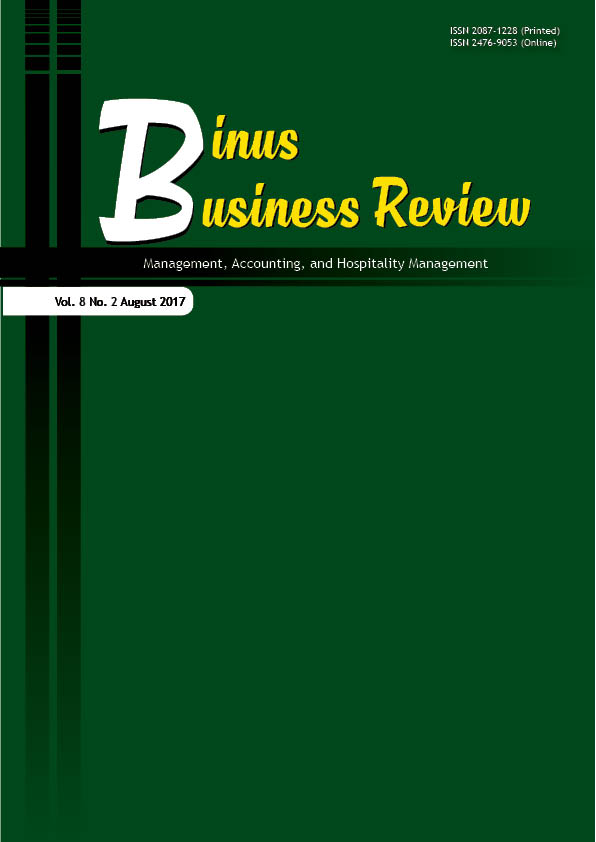The Evaluation of Bank Efficiency in Post Merger Stage in Banking Industry
DOI:
https://doi.org/10.21512/bbr.v8i2.1452Keywords:
bank technical efficiency, merger, analysis of variance, Data Envelopment AnalysisAbstract
This research evaluated the technical efficiency of the banks before and after the merger. This research observed 15 banks which involve in merger activities. This research used the Data Envelopment Analysis (DEA) method with variables of returns to scale (VRS) and input orientation. Analysis of variance (ANOVA) was also applied to test the difference between the technical efficiency in pre- and post-merger activities. This research finds that only six banks are efficient after the merger. Furthermore, four banks have a better technical efficiency than before, and
five banks have lower technical efficiency after the merger.
References
Avkiran, N.K., (1999). The evidence on efficiency gains: The role of mergers and the benefits to the public. Journal of Banking & Finance, 23(7), 1-39.
Bank Indonesia. (1999). Surat Keputusan Direksi Bank
Indonesia nomor 32/51/KEP/DIR/1999 tahun 1999 tentang persyaratan dan tata cara merger, konsolidasi dan akuisisi bank umum (Director’s Decree Number 32/51/KEP/DIR/1999 on terms and procedures of merger, consolidation and acquisition of commercial banks). Jakarta.
Coelli, T. J., Rao, D. S. P., O’Donnell, C. J., & Battese, G. E.
(2005). An introduction to efficiency and productivity analysis. New York: Springer Science & Business Media.
Coyle, B. (2000). Organic growth M&A, success or failure of strategic acquisitions. American Management Association.
Departemen Perizinan dan Informasi Perbankan. (2012). Statistik perbankan Indonesia vol. 10, no. 6. Jakarta: Bank Indonesia.
Departemen Perizinan dan Informasi Perbankan. (2013).
Statistik perbankan Indonesia. Jakarta: Bank Indonesia.
Drake, L., & Hall, M. J. (2003). Efficiency in Japanese banking: An empirical analysis. Journal of Banking & Finance, 27(5), 891-917.
Hadad, M. D., Santoso, W., Ilyas, D., & Mardanugraha, E. (2003). Analisis efisiensi industri perbankan Indonesia: Penggunaan metode non parametrik Data Envelopment Analysis (DEA). Research Paper, 7(5).
Hitt, M. A., Harrison, J. S., & Ireland, R. D. (2002). Merger
dan akuisisi: Panduan meraih laba bagi para pemegang saham. Jakarta: PT Raja Frafindo Persada.
Karray, S. C., & Eddine, J. C. (2013). Bank size and efficiency in developing countries: intermediation approach versus value added approach and impact of non-traditional activities. Asian Economic and Financial Review, 3(5), 593-613.
Liu, B., & Tripe, D. (2001). New Zealand bank mergers and efficiency gains. In the 14th Annual Australian Finance and Banking Conference. Sydney
Santoso, R. T. (2010). Pengaruh Merger dan Akuisisi Terhadap Efisiensi Perbankan di Indonesia (Tahun 1998-2009). Jurnal akuntansi dan keuangan, 12(2), 102.
Setiawan, M., Effendi, N., Emvalomatis, G., & Lansik, A. O. (2012). Banking efficiency and macroeconomic factors: evidence from Indonesian banking sector. Working Paper FEB Unpad, 35.
Setiawan, M., Emvalomatis, G., & Lansink, A. O. (2012).
The relationship between technical efficiency and industrial concentration: Evidence from the Indonesian food and beverages industry. Journal of Asian Economics, 23(4), 466-475.
Downloads
Published
How to Cite
Issue
Section
License
Authors who publish with this journal agree to the following terms:
a. Authors retain copyright and grant the journal right of first publication with the work simultaneously licensed under a Creative Commons Attribution License - Share Alike that allows others to share the work with an acknowledgment of the work's authorship and initial publication in this journal.
b. Authors are able to enter into separate, additional contractual arrangements for the non-exclusive distribution of the journal's published version of the work (e.g., post it to an institutional repository or publish it in a book), with an acknowledgment of its initial publication in this journal.
c. Authors are permitted and encouraged to post their work online (e.g., in institutional repositories or on their website) prior to and during the submission process, as it can lead to productive exchanges, as well as earlier and greater citation of published work.
USER RIGHTS
All articles published Open Access will be immediately and permanently free for everyone to read and download. We are continuously working with our author communities to select the best choice of license options, currently being defined for this journal as follows: Creative Commons Attribution-Share Alike (CC BY-SA)





















